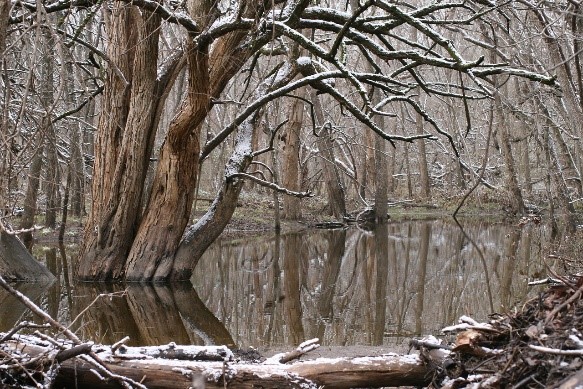Maclura pomifera, the North Texas native tree with seemingly as many common names as fruit, including Bois d’Arc, Osage Orange, Hedge Apple, Horse Apple, and Yellowwood, brings out a gamut of emotions and opinions. It is maligned as a nuisance while having books and festivals in its honor; it is full of thorns yet with eye-catching bark and fruit; it can be messy for landowners but has highly versatile and durable wood.

Bois d’Arc is not a tree you are likely to plant in your small suburban landscape. However, it has a history and characteristics that make it truly unique among our native North Texas plant species. For the uninitiated, the tree typically is 30 – 50 feet tall and often wider than tall. You can spot a Bois d’Arc in the summer through the female tree’s unmistakable light green fruit. The winter months highlight the fissured bark often interspersed with light brown streaks, which is usually a give-away about the species.
I find Maclura pomifera the most interesting of our native North Texas flora, and below are my top 16 reasons why I am fascinated by the tree:
History
Let’s start with the intriguing history of the tree:

- Formed during the Oligocene epoch, approximately 30 million years ago, Maclura pomifera, and possibly 6 other Maclura species, were widely spread across North America. It is believed that the tree and its cousins were distributed with the help of various extinct large herbivores, such as Giant Ground Sloths, Mastodons, and Mammoths.
- Fast forward to the end of the ice age, about 12,000 years ago, when these large herbivores were thought to be exterminated by early Native Americans. Without the seed dispersal of these herbivores, in North America, all the Maclura species except pomifera went extinct. By the time of the European exploration of the continent, their primary range had shrunk to an area encompassing Texas, Oklahoma, and Arkansas’ Blackland Prairies and Post Oak Savannas.
- A primary reason why the Bois d’Arc continued to flourish in our general area is that Native Americans, especially the Spiro culture, ensured its survival due to their prolific utilization of the tree. This included wide-ranging trade of the wood with other tribes for use in bows and other tools.
- Currently, Bois d’Arc trees are distributed across 39 states and Ontario, primarily due to 19th-century ranchers and farmers’ use of the tree in hedge rows.
Utility
From Native Americans to early European settlers, 20th-century ranchers, and all manner of people today, the Bois d’Arc possesses many beneficial traits.
- The common name of “Bois d’Arc” is French for “bow-wood”, a nod to Native Americans’ pervasive use in bows.
- Early Europeans witnessed the Native Americans’ utilization of the tree and also deployed it for a variety of purposes. Early settlers to North Texas set up thriving businesses in the distribution of the Bois d’Arc seeds for farmers across the nation to construct thick hedgerows and fencing for livestock pens. A common saying was the Bois d’Arc hedges were, “horse high, hog tight, and bull strong”.
- The proliferation was speedy, and by 1869, over 60,000 miles of Bois d’Arc hedges had been planted in the east, midwest, and south. Some scholars even consider the Maclura pomifera to be as crucial as the railroad, steel plow, and windmill for the European settlement of North America.
- The introduction of barbed wire in the 1880s began the decline of the tree’s use in hedges and fence posts. However, the Dust Bowl brought it back to the forefront with usage as part of the Works Progress Administration’s “Great Plains Shelterbelt” project to create hedges as windbreaks to prevent soil erosion.

Wood
Bois d’Arc wood has a unique coloration, hardness, and durability that makes it attractive to woodworkers, and artists that work in wood and fibers.
- The wood is extremely hard – rated at 2,620 pounds on the Janka Hardness scale, making it one of the hardest native North American woods.
- It is very durable when in direct contact with the soil, resulting in it being the most rot-resistant timber in North America.
- Aesthetically the wood is a dramatic bright yellow, then turning dark yellow to yellowish-brown upon exposure to the air. Many craftspeople utilize the wood shavings as a dye for natural fibers.
- As mentioned earlier, Native Americans used the wood for archery bows because it has the highest work to maximum load value of any wood, giving it a rare combination of strength and flexibility.
Fruit
An unmistakable part of the female trees is the large light green, highly dimpled fruit.

- Macula pomifera is part of the Mulberry family (Moraceae) and a relative of the Breadfruit, a widely planted fruit in tropical regions.
- The light green fruit, about 4 – 5 inches in diameter, is an aggregate of many small seeds. Unlike many fruits that primarily ripen on the tree, Bois d’Arc’s often fall well before they fully ripen.
- They are the largest fruit of any tree native to the United States.
- Today, very few native animals eat the fruit, one exception being squirrels, who only eat the seeds. Large introduced species such as horses will eat the fruit without harm.
Lastly, I am enough of a realist to know that I am likely in a small minority regarding my admiration of the Bois d’Arc. But hopefully these tidbits of information give you a greater appreciation for this fascinating tree. So please let us know your thoughts on Maclura pomifera.


